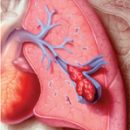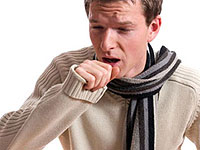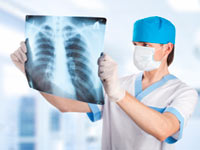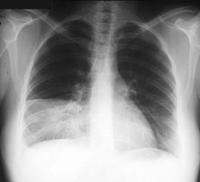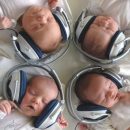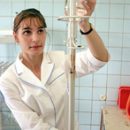Inflammation of lungs, or pneumonia, - symptoms, diagnosis and treatment of disease. Pneumonia in children and elderly - features of the course of the disease and symptoms.
Content
- What is pneumonia (lung inflammation)? Causes of the disease
- Symptoms of pneumonia
- Diagnosis of pneumonia
- Pneumonia — Treatment in children and adults
Pneumonia — Disease known to everyone. Classic symptoms of pneumonia went to the distant past. Today the disease may have a completely different person.
What is pneumonia (lung inflammation)? Causes of the disease
 In case of pathogenic microorganisms in the lung tissue, the infectious process begins. Microbes, multiplying and highlighting toxins, cause intoxication of the body and inflammation.
In case of pathogenic microorganisms in the lung tissue, the infectious process begins. Microbes, multiplying and highlighting toxins, cause intoxication of the body and inflammation.
The main way to distribute infection — Bronchogenic. The causative agent penetrates through the respiratory tract from the external environment or from the foci of infection in the nasophal. In some cases, microbes can spread with blood flow, lymph.
Risk factors for pneumonia
Risk factors for lung inflammation can be:
- immunodeficiency states;
- chronic foci of infection;
- smoking, alcoholism, drug addiction;
- hypodynamine;
- pregnancy;
- Operational interventions;
- Stagnant heart failure.
Microorganisms — Pneumonia pathogens
The disease can cause a large group of microorganisms — from bacteria to fungi and viruses. Bacteria Streptococcus Pneumoniae, Haemophilus Influenzae, Escherichia Coli, Klebsiella Pneumoniae are the cause of typical pneumonia. Legionella Pneumophila, Mycoplasma Pneumoniae, Chlamydia Pneumoniae, Pneumocystis Jirovecii, fungi and viruses cause an atypical shape.
Symptoms of pneumonia
The classic clinical picture of pneumonia consists of a number of symptoms:
- high temperature, fever;
- chills, weakness, dizziness;
- pain in the joints and muscles;
- wet cough with abundant purulent moocroty;
- Pain in the chest;
- Nausea and vomiting, tachycardia, drop in blood pressure.
Children's pneumonia occurs hard, which is still the main cause of death in children and the elderly. Her pathogen — Streptococcus Pneumoniae.
The course of this type of disease is distinguished by significant severity of symptoms, the severity of the state, frequent development of complications. Signs of respiratory failure manifest from the first day of the disease. Anatomically process captures from one lobe of the lung to total bilateral lesion.
Characterized high temperature up to 40-41 °C, expressed symptoms of intoxication, shortness of breath. After 3-4 days, a rusty sputum appears with blood and pus, cough. Complete recovery takes 2 months.
Symptoms of atypical pneumonia
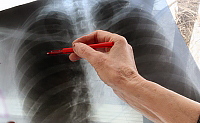 Atypical pneumonia is disguised as colds. It is characterized by a gradual beginning without explicit signs of lung defeat. Worried headaches, weakness, malaise. Possible subfebrile temperature. Dry cough, with poor sputum. Diagnosis of the disease is difficult, and ordinary antibiotics are not effective.
Atypical pneumonia is disguised as colds. It is characterized by a gradual beginning without explicit signs of lung defeat. Worried headaches, weakness, malaise. Possible subfebrile temperature. Dry cough, with poor sputum. Diagnosis of the disease is difficult, and ordinary antibiotics are not effective.
Symptoms and features of pneumonia in children
Pneumonia in breast children may have a low-power flow. In such cases, the main signs of inflammation of the lungs in children — This is a shortness of breath, increasing the frequency of breathing, signs of acute respiratory failure. Without treatment, the disease is a serious danger. According to 2010, pneumonia has caused 1.3 million children's death, 20% of them — under the age of five.
Pneumonia during pregnancy
Pneumonia — Frequent complication during pregnancy, especially in late terms. Physiological Weakening of the Immunal System «Unlock hands» Any infection. To couple with poor ventilation of the lower lungs, where conditions arise for the reproduction of microbes, this factor leads to a particularly severe course of pneumonia in pregnant women, with the development of septic complications, polyorgan deficiency.
Pneumonia in older people and old people
Often in the elderly, the disease proceeds asymptomatic. The patient complains of weakness, dizziness, sweating, shortness of breath. There is no temperature, cough, cold symptoms. The main cause of the disease is the reduced reactivity of the body at the old age.
Diagnosis of pneumonia
Basic methods of instrumental and laboratory diagnostics:
- Radiography of the chest;
- Pt chest;
- Microscopy and Bakposev Wet.
Timely diagnosis is significantly improved by the forecast. Success depends on the ability of a doctor to interpret the physical inspection of the patient pointing to the pneumonia.
Pneumonia — Treatment in children and adults
The basis for the fight against inflammation of the lungs — Antibacterial therapy. It is necessary to use the most effective preparations in optimal dosages. Efficiency is determined by bacteriological analysis (assessing the sensitivity of the pathogen to antibiotics). The first phase uses a wide range of action. After identifying the causative agent, the antibiotic is changed to a more efficient.
Expectorant and immunostimulating drugs are also introduced into the course of treatment.


